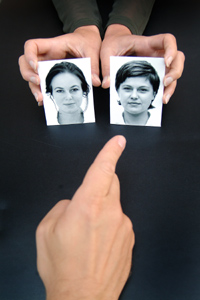 |
|

|
 |
Choice Blindness Experiment Sheds More Light On Decision Making Processes
Oct 9, 2005 - 12:17:00 AM, Reviewed by: Dr.
|
|
When evaluating facial attractiveness, participants may fail to notice a radical change to the outcome of their choice, according to a study by researchers at Lund University, Sweden, and New York University. Equally surprising, the study shows that participants may produce confabulatory reports when asked to describe the reasons behind their choices.
|
By Lund University Cognitive Science,
Researchers showed picture-pairs of female faces to the participants and asked them to choose which face in each pair they found most attractive. In addition, immediately after their choice, they were asked to verbally describe the reasons for choosing the way they did. Unknown to the participants, on certain trials, a card magic trick was used to secretly exchange one face for the other. Thus, on these trials, the outcome of the choice became the opposite of what they intended.
The researchers measured whether the participants noticed that something went wrong with their choice, both concurrently, during the experimental task, and retrospectively through a post-experimental interview. Less than 10% of all manipulations were detected immediately by the participants, and counting all forms of detection no more than a fifth of all manipulated trials were exposed. The researchers call this effect choice blindness.
Theories about decision-making generally assume that we recognize when our intentions and the outcome of our choices do not match up, but this study shows that this assumption is not necessarily correct. By shedding new light on the links between intentions and outcomes, these results challenges both current theories of decision making, and common sense notions of choice and self-knowledge.
The researchers also sought to understand if the verbal reports given by the participants differed between the faces that they actually chose, and the ones that they ended up with in a manipulated trial. "Based on common sense alone one might suspect that the reports given for normal trials and for the manipulated trials would differ in many ways", said Hall. "After all, revealing the reasons behind a choice is something we very often do in everyday life. But revealing the reasons behind a choice we did not make is a very strange thing indeed."
 |
| Choice Blindness Experiment. Photographer: Mark Hanlon |
However, using a variety of measures, the researchers found that the two types of reports were remarkably similar. ''When asked to motivate their choices, the participants delivered their verbal reports with the same confidence, and with the same level of detail and emotionality for the faces that that were not chosen, as for the ones that were actually chosen'' Johansson said.
Despite the intimate familiarity we have with everyday decision making, it is very difficult to determine what we can know about this process from the 'inside', by reflection and introspection. A great barrier for scientific research in this domain is the nature of subjectivity. How can researchers ever verify the reports of the participants involved, when they have no means of challenging them? But by using choice blindness as an instrument, the researchers were able to 'get between' the decisions of the participants and the outcomes they were presented with. "Our experiment introduces an entirely novel methodology that can be used to investigate choice and introspection'' Hall said. ''This may lead to an improved understanding of the processes behind both truthful and confabulatory reports'' 
- The findings appear in the October 7 issue of Science.
lucs.lu.se
The authors on this paper are Petter Johansson, a graduate student; Lars Hall, a researcher; Sverker Sikstr�m, an assistant professor; all from Lund University Cognitive Science; and Andreas Olsson, a graduate student in NYU's Department of Psychology.
|
For any corrections of factual information, to contact the editors or to send
any medical news or health news press releases, use
feedback form
Top of Page
|
|
|
|